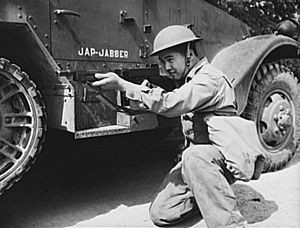
Back تاريخ الأمريكيين ذوي الأصول الصينية Arabic Geschichte der Chinesen in den Vereinigten Staaten German Inmigración china en los Estados Unidos Spanish 华裔美国人历史 Chinese

| This article is part of a series on the |
| History of the United States |
|---|
 |
The history of Chinese Americans or the history of ethnic Chinese in the United States includes three major waves of Chinese immigration to the United States, beginning in the 19th century. Chinese immigrants in the 19th century worked in the California Gold Rush of the 1850s and the Central Pacific Railroad in the 1860s. They also worked as laborers in Western mines. They suffered racial discrimination at every level of White society. Many Americans were stirred to anger by the "Yellow Peril" rhetoric. Despite provisions for equal treatment of Chinese immigrants in the 1868 Burlingame Treaty between the U.S. and China, political and labor organizations rallied against "cheap Chinese labor".
Newspapers condemned employers who were initially pro-Chinese. When clergy ministering to the Chinese immigrants in California supported the Chinese, they were severely criticized by the local press and populace.[1] So hostile was the opposition that in 1882, the U.S. Congress passed the Chinese Exclusion Act prohibiting immigration from China for the following ten years. This law was then extended by the Geary Act in 1892. The Chinese Exclusion Act was the only U.S. law ever to prevent immigration and naturalization on the basis of race.[2] These laws not only prevented new immigration but also the reunion of the families of thousands of Chinese men already living in the United States who had left China without their wives and children. Anti-miscegenation laws in many Western states also prohibited the Chinese men from marrying white women.[3] In the South, many Chinese American men married African American women. For example, the tenth U.S. census of Louisiana alone showed 57% Chinese American men were married to African American women, and 43% to European American women.[4]
In 1924, the law barred further entries of Chinese. Those already in the United States had been ineligible for citizenship since the previous year. Also by 1924, all Asian immigrants (except people from the Philippines, which had been annexed by the United States in 1898) were utterly excluded by law, denied citizenship and naturalization, and prevented from owning land. In many Western states, Asian immigrants were even prevented from marrying Caucasians.[5]
Only since the 1940s, when the United States and China became allies during World War II, did the situation for Chinese Americans begin to improve, as restrictions on entry into the country, naturalization, and mixed marriage were lessened. In 1943, Chinese immigration to the United States was once again permitted—by way of the Magnuson Act—thereby repealing 61 years of official racial discrimination against the Chinese. Large-scale Chinese immigration did not occur until 1965 when the Immigration and Nationality Act of 1965[6] lifted national origin quotas.[7] After World War II, anti-Asian prejudice began to decrease, and Chinese immigrants, along with other Asians (such as Japanese, Koreans, Indians and Vietnamese), have adapted and advanced. Currently, the Chinese constitute the largest ethnic group of Asian Americans (about 22%).
As of the 2020 U.S. census[update], there are more than 4.2 million Chinese in the United States, above 1.2% of the total population. The influx continues, where each year ethnic Chinese people from the People's Republic of China, Taiwan, and to a lesser extent Southeast Asia move to the United States, surpassing Hispanic and Latino immigration in 2012.[8]
- ^ Seager II, Robert (February 1959). "Some Denominational Reactions to Chinese Immigration to California, 1856-1892". Pacific Historical Review. 28 (1). University of California Press: Pacific Historical Review Vol. 28, No. 1, pp. 49-66: 49–66. doi:10.2307/3636239. JSTOR 3636239.
- ^ Chin, Gabriel J., (1998) UCLA Law Review vol. 46, at 1 "Segregation's Last Stronghold: Race Discrimination and the Constitutional Law of Immigration"
- ^ Chin, Gabriel and Hrishi Karthikeyan, (2002) Asian Law Journal vol. 9 "Preserving Racial Identity: Population Patterns and the Application of Anti-Miscegenation Statutes to Asian Americans, 1910–1950"
- ^ "The United States". Chinese blacks in the Americas. Color Q World. Retrieved 2008-07-15.
- ^ Bernfeld, Beatrice (May–June 2000), Asian Pacific Americans-enriching the evolving American culture, archived from the original on 2006-05-07, retrieved 2007-09-01
- ^ Gabriel J. Chin, "The Civil Rights Revolution Comes to Immigration Law: A New Look at the Immigration and Nationality Act of 1965," 75 North Carolina Law Review 273(1996)
- ^ "Chinese communities shifting to Mandarin", AP, 2003-12-29, archived from the original on 2004-06-04, retrieved 2013-09-18
- ^ "The Rise of Asian Americans". Pew Social and Demographic Trends: reports. Pew Research Center. June 19, 2012. Retrieved August 6, 2012.